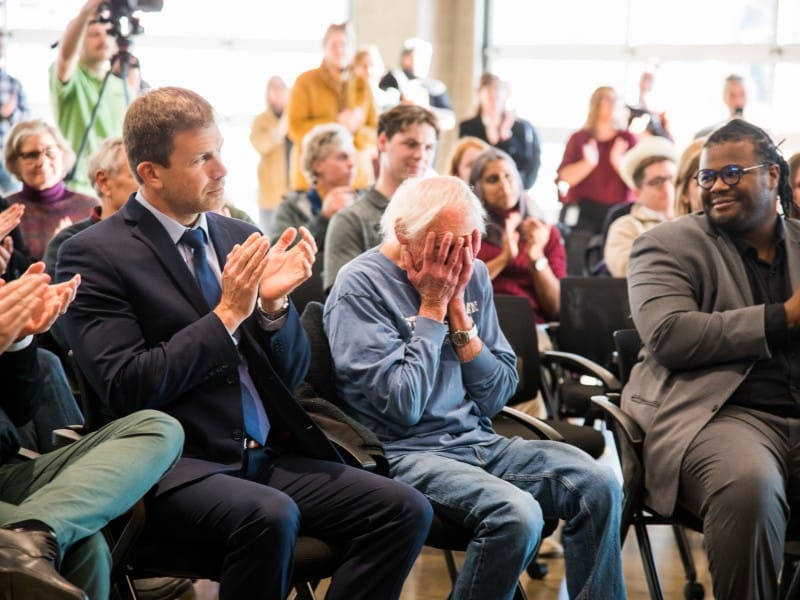This story was written by Thea Pipe, a 2023 graduate of Loy Norrix High School, as part of the Spring 2023 Kalamazoo Voices of Youth Program. The accompanying artwork was created by Lexi Tuley, also a 2023 graduate of Loy Norrix High School of the Voices of Youth Program. Please see Lexi’s Artist Statement below.
The Voices of Youth Kalamazoo program is a collaboration between Southwest Michigan Second Wave and KYD Network, funded by the Stryker Johnston Foundation.
When a transgender athlete was chosen to be a starter on the girls’ volleyball team at Kalamazoo’s Loy Norrix High School four years ago, Athletic Director Andrew Laboe recalls that a few parents objected. They felt that it was not fair.
“The athlete was easily good enough to make the team,” Laboe says. “And she was easily good enough to start on the volleyball team.”
The school supported the student.
“Our principal really came to the defense in the situation,” Laboe says. “He said: ‘This young lady is a member of the team, a part of the team. If the coach chooses her as a starter, she’s a starter. And that’s how we’re going to roll with this.’ ”
Laboe says Principal Chris Aguinaga took the stance that “I’m not going to hear any complaints about it. This is reality. This is what we’re doing. We’re following the rules. This is what we want to do. We want to create a great experience for her and maintain chemistry on that team.”
Nationwide, the participation of transgender athletes in sports has been hotly debated for the past few years. Lawsuits have been brought over the issue, most recently by a group of female track and field high school students in Connecticut.
The main questions that arise: Should someone who has transitioned from one gender to another be allowed to participate in sports according to the gender they identify as? Or should they compete with the gender they were assigned at birth?
Some people wonder whether trans athletes should be allowed to participate in sports at all. Others ask if they should be placed in a league of their own.
While those questions are being asked across the country, the focus seems to start at the high school level. So, we asked a few Loy Norrix High School students what they think.
What do students think?
There have been at least two openly transgender athletes at Loy Norrix High School in recent memory, according to Laboe. And both times, Laboe says, he has heard no complaints from fellow students, athletes, or others.
“I think it’s definitely something that people take into consideration when trans athletes do want to play, and it’s like a deterrence (departure) from tradition,” says Nadia Abbott, an 18-year-old senior at Loy Norrix. “But I think that there’s many, like biological women, that can go against a biological man and they’re better. So, I feel like if there’s like a biological who is (trans) to become a woman, I feel like it shouldn’t change things.”
What about someone who started biologically as a woman and has transitioned into a man? Should there be concern about them competing against men? And is that safe in sports like boxing or MMA (mixed martial arts)?
Says Abbott: “I think that just depends on the person because that means you don’t see that person as who they are. So, I think that’s really the problem there. I don’t think it’s more of like a strength thing. I think it’s more of like perceiving people how they’re portraying themselves.”
Elsie Lewis, a 15-year-old sophomore at Loy Norrix says she’s not trans so she doesn’t think she has a lot of room to speak on the matter. But, “I think it is fair for someone who identifies as male to be competing against biological males, and someone who identifies as female to be competing against biological females,” she says.
Does she worry about sports remaining competitive? Some people say that, if someone started as a male and is competing against females, it’s not fair, even if they take hormones that reduce their strength and muscle mass. They argue that that person is still bigger and stronger.
“I dunno’,” Lewis says. “I don’t think it’s that serious at that point, you know.” And she says, “There’s rules in sports to keep people safe. So why does it matter what gender you are?”
A 16-year-old male student who did not want to be named says, “I personally think it’s not fair. But that’s my opinion.” He is especially against trans athletes born male competing against females.
“It’s unfair competition because they still have male genetics and they’re competing against girls,” he says.
New bills, guidelines
New proposed rules issued by the U.S. Department of Education in April prohibit schools and colleges from banning transgender students from joining sports that alight with their gender identity, although there are some limited exceptions.
At the same time, efforts are underway in some states to put laws on the books affecting what transgendered people can and cannot do.
In Michigan, six such bills are being proposed. Three of them specifically impact transgender students and athletes.
Bills HB4195 and HB4510 both propose to restrict access to restrooms and locker rooms based on biological sex, thereby barring transgender students from using the space they may feel most comfortable in. Bill HB4546 would require that athletes on a publicly funded team be scored based on their biological sex, regardless of identity or progression through transitioning.
At Loy Norrix High School, trans athletes have been able to play sports basically without incident. Two athletes have joined teams of the gender opposite of the one they were assigned at birth in the last few years. And there have been other athletes who identify as transgender or as nonbinary who choose to participate on teams for the gender they were assigned at birth.
“It’s such a complicated topic right now and unfortunately this is an area where politics intersects to a degree,” says Loy Norrix Principal Chris Aguinaga. “Fortunately for trans athletes in Kalamazoo, our school board has a policy against discrimination based on gender identity. And I feel accomplished that we were able to have two trans (male-to-female) athletes being able to compete in female sports competitively at the state level with the Michigan High School Athletic Association supporting them.”
The first trans athlete participated on the girls’ volleyball team in the 2019-2020 school year. The second participated on the girls’ swim and dive team during the 2022-2023 school year, and then the girls’ track team as a pole-vaulter and long-jumper during the last school year and the one previous to that. Both endured little to no difficulties in their participation in their sports.
“One of the biggest barriers for trans athletes is the locker room,” Aguinaga says. But trans athletes use the locker rooms of their accepted gender at Loy Norrix and the principal says he has not received any complaints about it from students or parents. He says he knows some other schools require trans athletes to dress separately or in a designated area that has been provided.
“I think people create these images that something horrible is going to happen,” Aguinaga says. “But, in all reality, it doesn’t. Everybody just blends together.”
Aguinaga says he has heard concerns from community members who don’t have kids in the school. “From actual parents who have kids in my school,” he says, “I’ve received zero concerns.”
Asked if people should assume he is biased about issues involving trans people because of his own background about which he is open, Aguinagua says: “I’m a gay male, I sit on the board of our local LGBTQ organization, Outfront Kalamazoo. And so, in structure, I have a bias that is probably pro-trans.”
But he says he understands there are inequities and unfairness in how people are treated everywhere. As a white man, he says he knows he may receive better treatment even within the LGBTQ community. And, he says, “At the end of the day, I want equity for everybody regardless of orientation, identity, color, gender, etc.”
MHSAA: ‘Super supportive’
Loy Norrix High School Athletic Director Andrew Laboe called the Michigan High School Athletic Association “super supportive” of trans athletes. He says MHSAA tries to be consistent in each situation, so it treats everyone the same. The MHSAA has requirements that trans athletes must follow before they can compete.
The association has guidelines for the process of taking hormones, for instance, including which hormones are being taken, how long they are taken, and whether they are prescribed by a physician. And individuals have to have evidence of hormone therapy or surgical procedures.
Aguinaga says he does not know how many transgender students the school has because some may not have come out as trans. What is known is that Loy Norrix has approximately 1,700 students. Of them, about 800 are involved in some sort of MHSAA-sanctioned sport or activity. There were about 200 students involved in track and field alone at Loy Norrix this past spring.
Mustafa Mohamad, an 18-year-old senior, says he knew a trans athlete at the school two years ago who may have not been well-known to school officials. He recalls the student having trouble entering races and clubs in her sport because she was transgender. That athlete was born male and wanted to compete as a female. Mohamad says she did well academically but dropped out of school. He does not know what she’s doing today.
“I tried to talk some sense into her,” Mohamad says. “But she said, ‘No, I can’t go to school where they treat me bad.’ And I was like, ‘Well, I’m your friend. What about me?’ ”
Mohamad says he thinks trans athletes should be allowed to compete as trans athletes.
Aguinaga says he has not had any controversy with visiting teams or when one of his school’s teams is on the road. Before the COVID-19 outbreak, he says there was one instance in which a parent he knows made some unsavory remarks about trans athletes. The principal says that after they had a conversation, that parent understood the school’s position as well as Aguinaga’s.
The school district prohibits discrimination based on gender identity or sexual orientation. Aguinaga supports that position, saying, “At the end of the day, I just want everybody to feel comfortable in their own skin. And I want everybody to be happy.”
More student voices
Seventeen-year-old senior Linnea Holm doesn’t “really understand why people care so much” if trans athletes compete in the teams of the gender they identify as.
“I understand some people see it as like an advantage or whatever,” Holm says. “But, like, at the end of the day, it’s just sports.”
Shawndell Glenn, a 14-year-old freshman, is also supportive of trans athletes. One of his friends at Kalamazoo Central High School is a trans person. She started as a girl and hopes one day to join a men’s sport at the school. Although Glenn says the athlete is a pretty good player and has not had a lot of problems, he has faced some discrimination.

“It’s just people discriminating about it,” Glenn says, “like (saying) how she wouldn’t be good at it and stuff. And they talk about how she wants to be a boy and stuff. But she don’t listen to any of that.”
Does he foresee trans people being in sports competing on a regular basis? Glenn says, “Yeah.”
Isaiah McBride, a 17-year-old junior, says trans athletes “should be able to do things they want to do and shouldn’t be just excluded from anything just because they are the way they are.”
But he adds: “I personally believe they should probably have like their own (sports) bracket, so it’s more fair because you do have some biological characteristics that might give you an advantage. But I feel like they should still be treated equal and fairly.”
Max Ruegsegger is an 18-year-old nonbinary athlete who plays softball. Since she says she was born a female and is not going through any hormonal changes, she competes strictly in women’s sports. She also competes in sports recreationally outside of school and in some co-ed leagues, such as volleyball and softball.
She says she thinks trans athletes should be allowed to compete with which the gender they identify. But she says, “I do agree that there should be some requirements, just to calm some other people down.”
Of the uproar last year over trans swimmer Lia Thomas winning the National Collegiate Athletic Association’s women’s swimming championship in the 500-yard freestyle, Ruegsegger applauds Thomas for having done “really, really well.”
“But people were like, ‘She’s trans. It doesn’t count,’ ” says Ruegsegger.
Ruegsegger says the swimmer had been on estrogen for about a year and a half before she was allowed to compete with women “and people still had a problem with it.”
“It just doesn’t sit right with them (some people) when you’re not biologically born (in the gender you’re competing against),” Ruegsegger says. “You don’t have the same chemicals and stuff, or hormones.”
Kiano Long, a 17-year-old junior, agrees trans athletes should be allowed to compete.
“They’re athletes,” he says. “I’m not really big into sports and stuff though. But if this is the one thing about some trans athletes not being allowed to play in – let’s say women’s sports – because they’re a trans athlete, I think that’s kind of dumb.”
What the future brings over the next five years is anyone’s guess, but some of the students and educators interviewed have some thoughts.
Says Ruegsegger: “Knowing our society now, I see that we’ll have strictly trans leagues where trans girls will compete with other trans girls, which I don’t necessarily agree with. I think trans girls should be included on regular girls’ teams and trans men should be included on regular men’s teams. But with the way that our society sees those things, the most I think we’ll get within the next couple of years are strictly trans teams. I think that will be the extent of the inclusivity until further down the line.”
Principal Aguinaga has a brighter outlook.
“The issue, to be blunt, is there is a segment in society that feels that students who are biologically born male and then transition to female have physical characteristics that give them an unfair advantage in female athletics,” he says. “In both cases that we’ve had in our high school, that has not been the case. And, at the end of the day, everybody was accepted and everybody had fun and everybody was happy. And quite frankly, if everybody is happy, I’m happy.”

Voices of Youth writer Thea Pipe is a transgender varsity athlete and graduating senior of Loy Norrix High School who worked for Knight Life, the school’s student newspaper. She plans to major in environmental biology and journalism at Michigan State University.
Artist Statement: Lexi Tuley
“To me, art has always been an outlet for creativity. It’s a way to make my thoughts and ideas real. I love the freedom I have in art. The variety of things I can make is amazing to me. In this piece, I was focusing on trans athletes and the difficulties they face. Everyone is always arguing about what teams they should be allowed to play on, and what advantages they do or do not have. People rarely listen to the athletes themselves, and what they want.
“In this piece, I specifically wanted to show how trans athletes have to do more work than cisgender athletes. I used colored pencils and watercolor on paper on an old cereal box to create the visualization of trans athletes having harder work to do than the cis athlete, since the trans athletes’ crossbar is so much higher. I’m not an athlete and am not trans, but I do know that we need to listen to the people whose lives these conversations affect. Instead of deciding what we think is best, we need to let trans athletes be their own voices.”

Voices of Youth’s Lexi Tuley is a 17-year-old junior at Loy Norrix High School. Lexi loves reading, writing, making artwork, and playing video and board games. Lexi plans on going to Wayne State University to study Library Science or Museology or maybe both.















